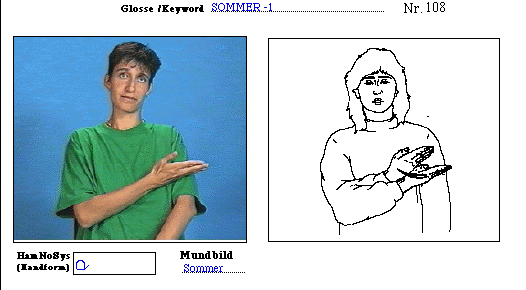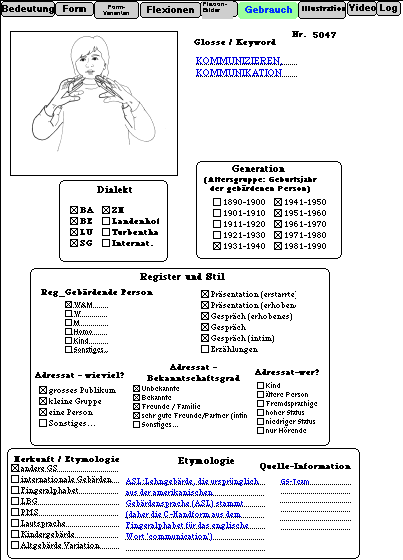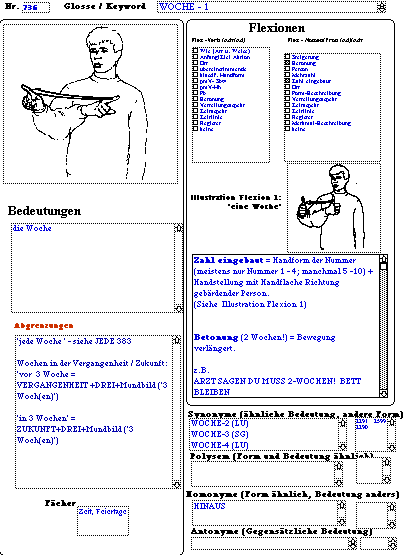

| 1. Aims of the Databank for Swiss German Sign Language
2. Types of information documented for each sign 3.1. Initial monolingual collection |
Although courses for learning Swiss German Sign Language (Deutschschweizerische Gebärdensprache, DSGS) and programs for the training of DSGS teachers and interpreters have existed for several years in German Switzerland, there is as yet no dictionary for this language. The aim of the multimedial bilingual DSGS-German databank is to provide a documentation of the DSGS lexicon that will serve as a tool for linguistic research as well as provide a basis for the production of signed language materials such as dictionaries (in book and electronic form) and teaching materials.
The Databank project is a five year project (1996-2001) financed by the Swiss Science Foundation (Schweizerischer Nationalfonds) as well as by several Swiss German organizations which have a need for signed language materials (for example, the training programs for DSGS teachers and interpreters), and by private donations. The 3000 signs being collected in this project clearly represent only a small portion of the DSGS lexicon. However, this set of signs will include the core vocabulary necessary for DSGS courses, communication with deaf children and for basic interpreting situations. The linguistic and technological methodologies developed in this project will also facilitate future additions to the databank collection.
The rapid and convenient cross-reference searches of the data facilitate both linguistic research and the production of end-user applications. Future products, such as DSGS dictionaries and CDs or DVDs can thus be more easily tailored for specific audiences; e.g. dictionaries for parents of young deaf children, teaching materials for use in schools, special vocabulary items and sentence examples for use by medical personnel, etc.
The purpose of the Databank project is primarily scientific: to provide a linguistic documentation of the lexicon of the language. In order to make the collected information more publicly accessible, the Databank project works closely with GS-MEDIA (gsmedia@dplanet.ch), an organization founded in 1999 for the production and distribution of commercial products that utilize the data in the signed language Databank.
For each sign entry, the databank contains information about its form, variants as well as different kinds of linguistic descriptions.

The base form of the sign is documented in the following ways:


The underlying principle of the linguistic methodology is that as much information about the sign as possible is collected and analyzed first in DSGS by deaf team members, with as little as possible reference to German. This initially monolingual approach is used to ensure that the signs being collected are actually used by the local deaf signing community and are not being produced (or in extreme cases, invented) by informants primarily to translate German words presented by a researcher.
The collection in the project's first phase (1996-1999) targeted signs for topics most often discussed within the deaf community. Pilot studies made by the deaf team indicated that these topics include 'sports', 'medical situations' and 'school'. Also included in the first phrase were the basic sign vocabulary used in the DSGS courses organized by the Swiss German Deaf Association. Targeted signs in the second phase of collection (1999-2001) are signs used with preschool and primary school age children. In addition, the Databank is working with the DSGS Interpreter Training Program in Zurich to collect signs for legal situations.
DSGS does not have one standardized form but consists of five dialects centered around the deaf schools in Basel, Bern, Luzern, St. Gallen, and Zürich. Initial collection of signs on a theme is usually done within a uniform group of deaf users of one dialect. Checks are then made to determine if the signs collected for that dialect are also used in other dialects. As the deaf team members who collect the signs sometimes use a different dialect than that of the subject group, special elicitation materials and methods had to be developed that would avoid the subjects' signing being influenced by the researcher's dialect. For some topics (for example, health problems, legal problems, AIDS), signs were elicited in individual interviews conducted by a deaf team member with whom the subject felt comfortable. Deaf staff members did all elicitation-filming sessions.
The subjects are informed of the purpose of the databank collection and asked to sign a permission form indicating which groups of persons have their permission to see the videotapes with their signing. The potential groups of viewers range from only the Databank team (everyone, only males, only females); to classes for training deaf signed language teachers or hearing interpreters; other signed language researchers; DSGS classes for the general public; public workshops, conferences and the media. The deaf researcher also fills out a questionnaire about the subject's self-judged language competence in the different DSGS dialects, in other signed languages and in spoken languages. Included in this questions is also information about the subject's age of signed and of spoken language acquisition, age and extent of hearing loss, and contact with other deaf persons in the family and deaf community. Each informant is given a number and all background information stored in a separate 'informant databank'. In the main lexical databank, all references to informants are made via their informant number. The Databank offers to pay the travel expenses and a small fee to subjects. (Many of the deaf subjects have donated their fee and expenses to the Databank project.)
Copies with an overlaid time code are made of the initial collection videotapes. From these 'working copies', video prints are made of targeted signs. Each of these signs is given a sign identification number, which is recorded on a paper form and as an entry in the lexical databank. The deaf researchers together with the project director analyze the meanings, discuss synonyms, antonyms, as well as register restrictions. The deaf team members make videoclips of targeted signs in the context of a signed sentence. These example sentences are then translated into written German by trained DSGS-German interpreters.
One deaf team member is responsible for the HamNoSys phonetic notation of each entry. At the current time, only the hand shape and location are being notated in HamNoSys. A small group of DSGS deaf signers are also developing a version of 'Sutton SignWriting' for the writing of DSGS signs. The plan is, by the end of the project (2001), to have a SignWriting notation for each base entry in the databank. One of the reasons for the use of this notation is so that deaf children learning DSGS will have a means of writing and reading their first (signed) language.
A great deal of log information is needed to keep track of the progress of different phases of the documentation. The following are examples of the logs kept:
Hardware: Macintosh network linked by Ethernet
Software: FileMaker Pro 4.0/4.1 (clients), FileMaker Server 3.0 (server)
The current database was developed for research purposes. As of November 1999, it is non-relational and includes text, video stills, and illustrations. Videoclips of signed examples have been filmed but are not yet in the databank. Scheduled for 1999-2001 are the following changes and additions: The database will be restructured in a relational design, videoclips will be included after introducing videostreaming technology on the network; all new videotaping will be done with digital technology. Also within this time period, Lasso software will be used for a connection to an Internet website for the Databank.
Phase 1 (1996-1999): Director: Penny Boyes Braem (hearing)
Linguistic collection and analyses: Gian-Reto Janki (deaf), Claudia Jauch (deaf), Carmen Steiner (deaf), and Brigitte Vogel (deaf);
Illustrations: Daniel Gundi (deaf), Stephanie Hirsbrunner (deaf), Jovita Lengen (deaf), Daniela Rhyner (deaf), Katja Tissi (deaf);
Computer technology: Christian Lukasczyk (hearing)
Phase 2 (1999-2001): Director: Penny Boyes Braem (hearing)
Linguistic collection and analyses: Doris Koller (deaf), Carmen Steiner (deaf), Brigitte Vogel (deaf)
Illustrations: Jovita Lengen (deaf), Daniela Rhyner (deaf)
Computer technology: Christian Lukasczyk (hearing)
Gebärdensprach-Datenbank
Oerlikonerstrasse 98
CH-8057 Zürich, Switzerland
Fax: (++41) (0) 1 312-1363
mailto:gsdatenbank@access.ch
Posted: 25.01.2000